A small range inside day leaves the Elliott wave counts and targets unchanged.
Summary: A short-term target for the middle of a third wave to end is now at 3,097. A mid-term target for a third wave at intermediate degree is at 3,148.
Use the best fit trend channel as a guide to where pullbacks may find support along the way up.
The biggest picture, Grand Super Cycle analysis, is here.
Monthly charts were last published here, with video here. There are two further alternate monthly charts here, with video here.
ELLIOTT WAVE COUNTS
The two weekly Elliott wave counts below will be labelled First and Second. They may be about of even probability. When the fifth wave currently unfolding on weekly charts may be complete, then these two wave counts will diverge on the severity of the expected following bear market. To see an illustration of this future divergence monthly charts should be viewed.
FIRST WAVE COUNT
WEEKLY CHART
The basic Elliott wave structure consists of a five wave structure up followed by a three wave structure down (for a bull market). This wave count sees the bull market beginning in March 2009 as an incomplete five wave impulse and now within the last fifth wave, which is labelled cycle wave V. This impulse is best viewed on monthly charts. The weekly chart focusses on the end of it.
Elliott wave is fractal. This fifth wave labelled cycle wave V may end a larger fifth wave labelled Super Cycle wave (V), which may end a larger first wave labelled Grand Super Cycle wave I.
The teal Elliott channel is drawn using Elliott’s first technique about the impulse of Super Cycle wave (V). Draw the first trend line from the end of cycle wave I (off to the left of the chart, the weekly candlestick beginning 30th November 2014) to the end of cycle wave III, then place a parallel copy on the end of cycle wave II. This channel perfectly shows where cycle wave IV ended at support. The strongest portion of cycle wave III, the end of primary wave 3, overshoots the upper edge of the channel. This is a typical look for a third wave and suggests the channel is drawn correctly and the way the impulse is counted is correct.
Within Super Cycle wave (V), cycle wave III is shorter than cycle wave I. A core Elliott wave rule states that a third wave may never be the shortest. For this rule to be met in this instance, cycle wave V may not be longer in length than cycle wave III. This limit is at 3,477.39.
Within cycle wave V, primary waves 1 and 2 may now be complete. Within primary wave 3, no second wave correction may move beyond its start below 2,728.81.
Cycle wave V may subdivide either as an impulse or an ending diagonal. Impulses are much more common. Ending diagonals normally have second and fourth waves that are deep; the common depth is from 0.66 to 0.81 the prior wave. So far a correction within cycle wave V has not been deeper than 0.5, so a diagonal at this stage looks very unlikely (but remains possible).
In historic analysis, two further monthly charts have been published that do not have a limit to upwards movement and are more bullish than this wave count. Members are encouraged to consider those possibilities (links below summary) alongside the wave counts presented on a daily and weekly basis.
The daily chart below will now focus on price movement from the low of primary wave 2.
DAILY CHART
Cycle wave V must subdivide as a five wave motive structure. Within that five wave structure, primary waves 1 and 2 may be complete.
Primary wave 3 must move above the end of primary wave 1 (this rule has now been met). Primary wave 3 may only subdivide as an impulse.
This wave count now sees a series of six first and second waves complete: primary, intermediate, minor, minute, minuette and subminuette. The middle of a third wave up may be underway. It may be expected to exhibit some increase in momentum, and it may have support from volume.
Within minute wave iii, no second wave correction may move beyond the start of its first wave below 2,973.09.
HOURLY CHART
This wave count now sees a series of six first and second waves complete. This wave count now expects further strength in upwards movement.
The last pullbacks labelled minute wave ii, minuette wave (ii) and then micro wave 2 have all found support about the lower edge of the best fit channel. This trend line may continue to show support.
Subminuette wave iii has now moved above the end of subminuette wave i, meeting a core Elliott wave rule, but it has not yet moved far enough above the end of subminuette wave i to allow room for subminuette wave iv to unfold and remain above subminuette wave i price territory. Therefore, it may be expected for subminuette wave iii to continue to move higher.
Within subminuette wave iii, the correction for micro wave 4 may not move into micro wave 1 price territory below 3,008.56.
SECOND WAVE COUNT
WEEKLY CHART
This weekly chart is almost identical to the first weekly chart, with the sole exception being the degree of labelling.
This weekly chart moves the degree of labelling for the impulse beginning in March 2009 all down one degree. This difference is best viewed on monthly charts.
The impulse is still viewed as nearing an end; a fifth wave is still seen as needing to complete higher. This wave count labels it primary wave 5.
TECHNICAL ANALYSIS
WEEKLY CHART
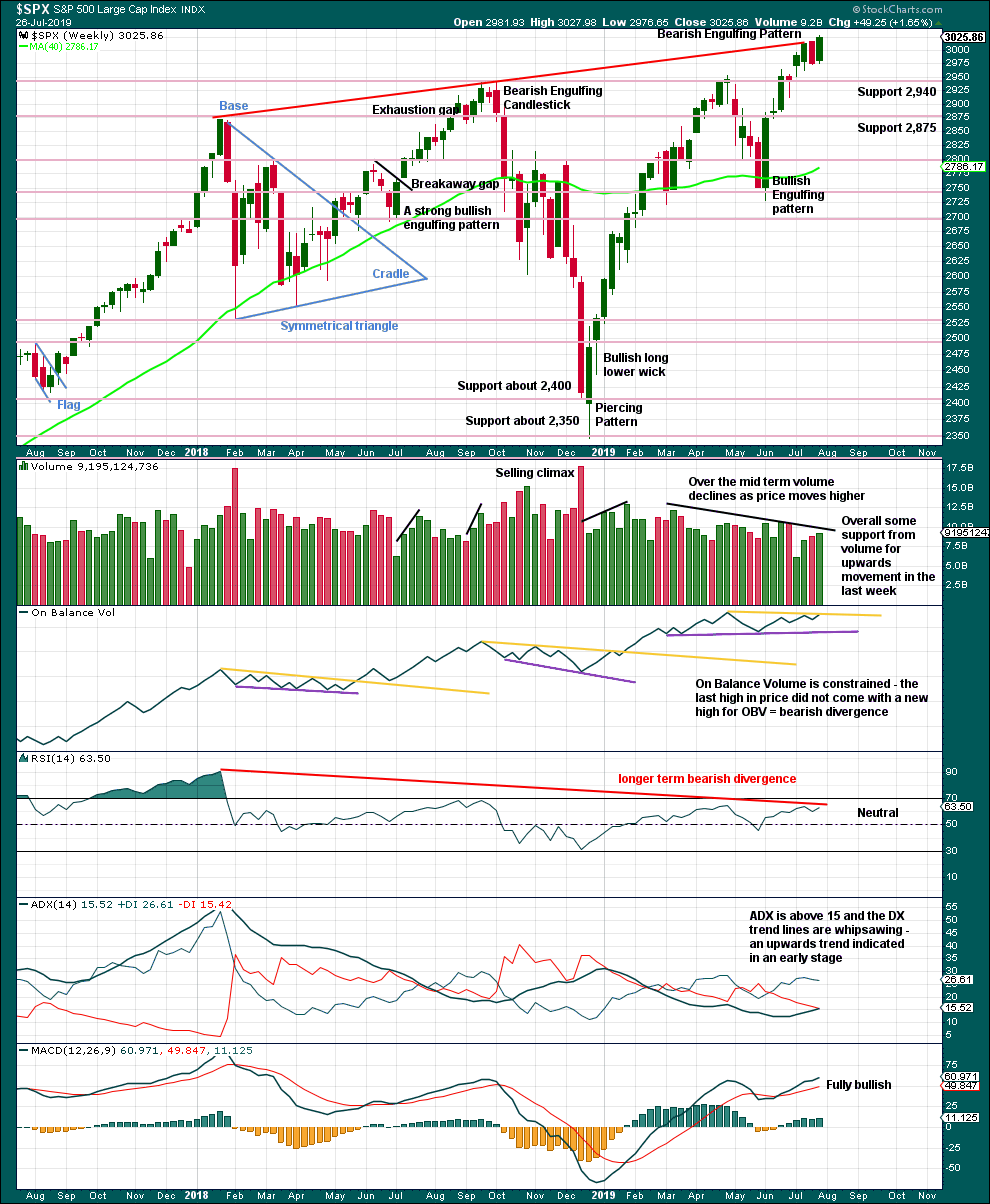
Click chart to enlarge. Chart courtesy of StockCharts.com.
Last week volume offers some support to upwards movement, although the longer-term trend of declining volume with rising price persists.
Bearish divergence between price and On Balance Volume is too slight to be given much weight in this analysis. Sometimes this can just disappear, particularly when it is very weak.
Longer-term bearish divergence between price and RSI may develop further before a larger downwards trend begins to resolve it.
The strongest signal ADX can give is when it rises up from low levels and below both directional lines to 15 or above. Last week ADX gives a strong signal for an upwards trend, which may be in its relatively early stages.
DAILY CHART
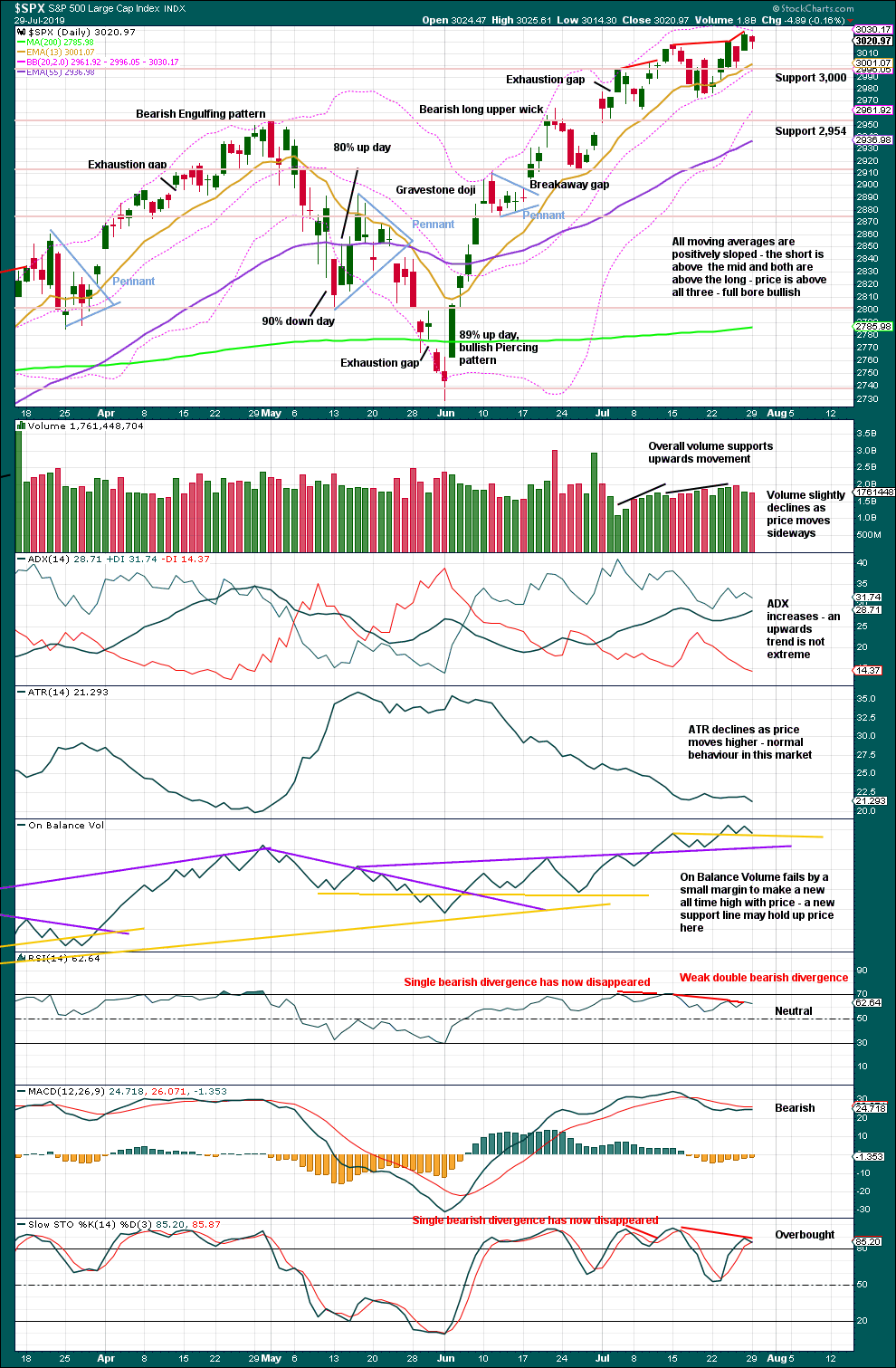
Click chart to enlarge. Chart courtesy of StockCharts.com.
ADX at both daily and weekly chart levels indicates an upwards trend which is not extreme at either time frame.
The small bearish divergence between price and On Balance Volume is not given weight. It is too short term and too weak; it may simply disappear. Likewise, short-term bearish divergence between price and RSI may also disappear.
Support about 3,000 has been tested and has held. It may continue to do so.
A new support and resistance line is added to On Balance Volume. This may assist here to hold up price.
BREADTH – AD LINE
WEEKLY CHART
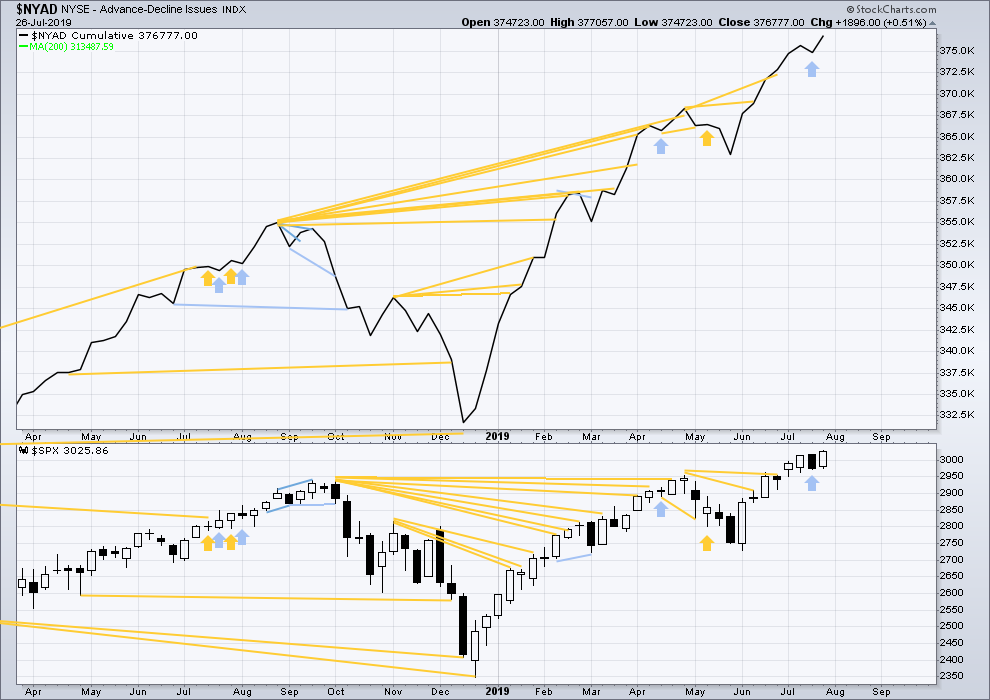
Click chart to enlarge. Chart courtesy of StockCharts.com. So that colour blind members are included, bearish signals
will be noted with blue and bullish signals with yellow.
Bear markets from the Great Depression and onwards have been preceded by an average minimum of 4 months divergence between price and the AD line with only two exceptions in 1946 and 1976. With the AD line making new all time highs again this week, the end of this bull market and the start of a new bear market is very likely a minimum of 4 months away, which is mid November 2019.
In all bear markets in the last 90 years there is some positive correlation (0.6022) between the length of bearish divergence and the depth of the following bear market. No to little divergence is correlated with more shallow bear markets. Longer divergence is correlated with deeper bear markets.
If a bear market does develop here, it comes after no bearish divergence. It would therefore more likely be shallow.
Last week both price and the AD line make new all time highs on the weekly chart. There is no divergence.
Mid caps have now made a new all time high last week, but small caps remain below their all time high of 25th February 2019. Weakness is now predominantly in small caps. This is normal behaviour during the later stages of a bull market, and may be expected to develop further before the bull market may end. Tops are a process and that process may last months to even years.
DAILY CHART
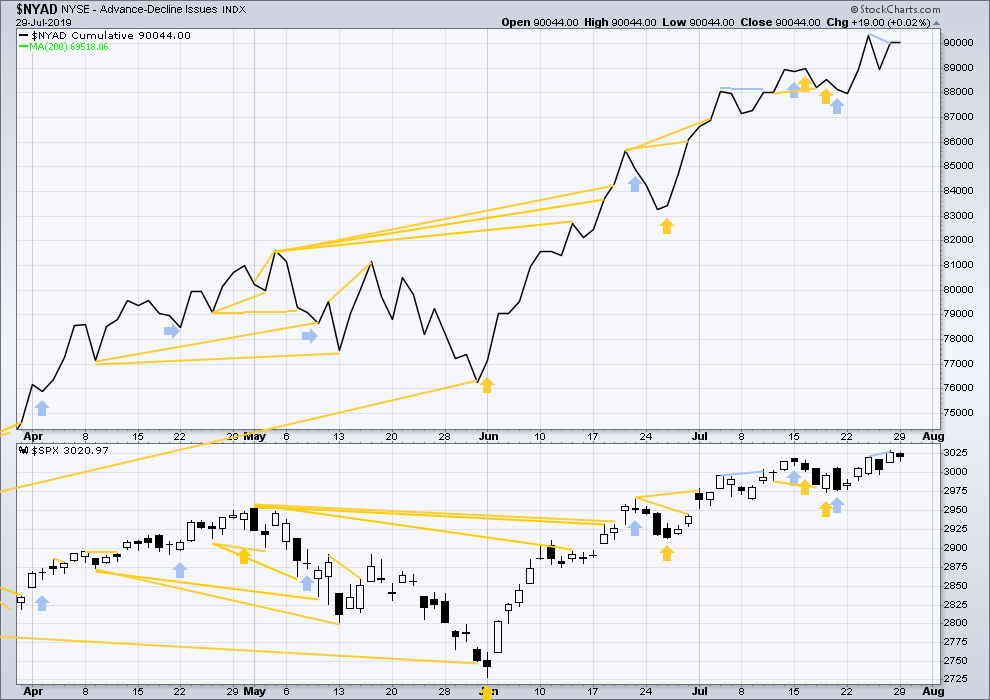
Click chart to enlarge. Chart courtesy of StockCharts.com. So that colour blind members are included, bearish signals
will be noted with blue and bullish signals with yellow.
Breadth should be read as a leading indicator.
Bearish divergence between the AD line and price for the short term noted in last analysis has now been followed by a red daily candlestick. It may be resolved here, or it may yet be followed by some downwards movement.
Today price completed an inside day and the AD line is essentially flat. There is no divergence.
VOLATILITY – INVERTED VIX CHART
WEEKLY CHART
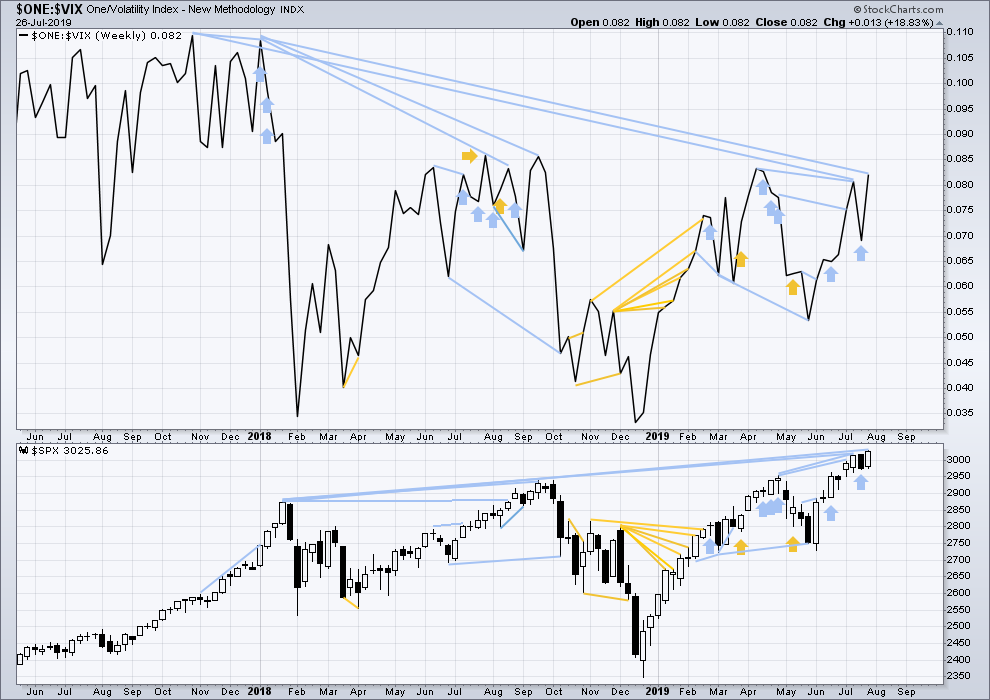
Click chart to enlarge. Chart courtesy of StockCharts.com. So that colour blind members are included, bearish signals
will be noted with blue and bullish signals with yellow.
The all time high for inverted VIX (which is the same as the low for VIX) was on 30th October 2017. There is now nearly one year and eight months of bearish divergence between price and inverted VIX.
The rise in price is not coming with a normal corresponding decline in VIX; VIX remains elevated. This long-term divergence is bearish and may yet develop further as the bull market matures.
This divergence may be an early warning, a part of the process of a top developing that may take years. It may not be useful in timing a trend change.
Last week price has made a new all time high, but inverted VIX still exhibits longer-term bearish divergence. For the short term, there is no divergence between price and inverted VIX for the last swing high two weeks ago.
DAILY CHART
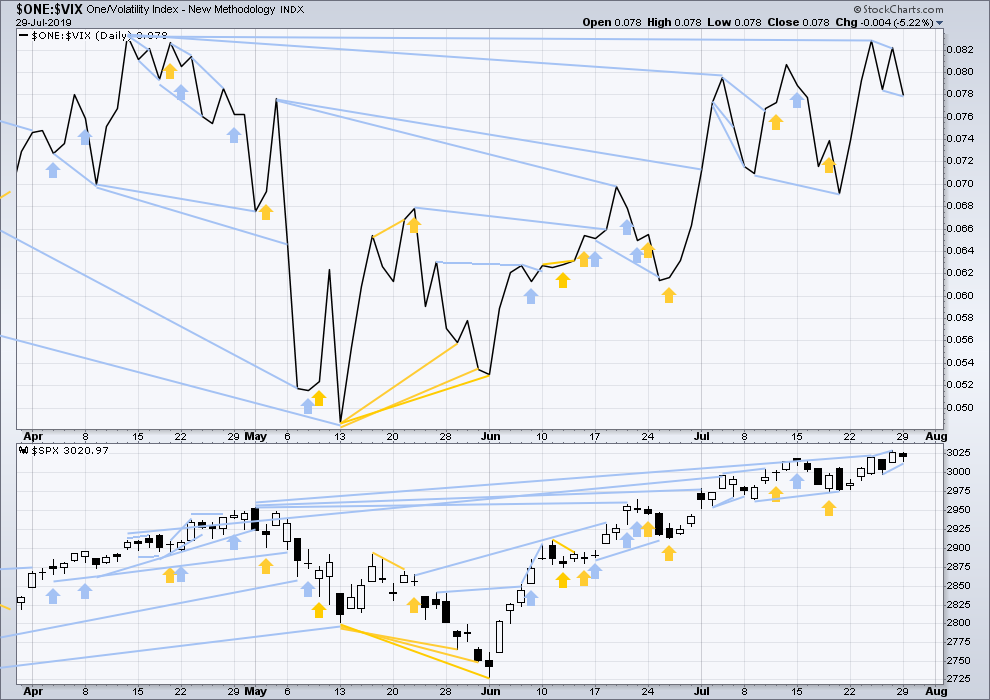
Click chart to enlarge. Chart courtesy of StockCharts.com. So that colour blind members are included, bearish signals
will be noted with blue and bullish signals with yellow.
Bearish divergence noted in last analysis has been followed by a red daily candlestick. It may be resolved here, or it may yet be followed by some downwards movement.
Today price has moved sideways and inverted VIX has declined. Inverted VIX has made a new short term low below the low of two sessions prior, but price has not. This divergence is bearish for the short term, but it will not be given weight in this analysis as it is not confirmed by the AD line and / or On Balance Volume.
DOW THEORY
Dow Theory confirmed a bear market in December 2018. This does not necessarily mean a bear market at Grand Super Cycle degree though; Dow Theory makes no comment on Elliott wave counts. On the 25th of August 2015 Dow Theory also confirmed a bear market. The Elliott wave count sees that as part of cycle wave II. After Dow Theory confirmation of a bear market in August 2015, price went on to make new all time highs and the bull market continued.
DJIA: 23,344.52 – a close on the 19th of December at 23,284.97 confirms a bear market.
DJT: 9,806.79 – price has closed below this point on the 13th of December.
S&P500: 2,532.69 – a close on the 19th of December at 2,506.96 provides support to a bear market conclusion.
Nasdaq: 6,630.67 – a close on the 19th of December at 6,618.86 provides support to a bear market conclusion.
With all the indices having moved higher following a Dow Theory bear market confirmation, Dow Theory would confirm a bull market if the following highs are made:
DJIA: 26,951.81 – a close above this point has been made on the 3rd of July 2019.
DJT: 11,623.58 – to date DJT has failed to confirm an ongoing bull market.
S&P500: 2,940.91 – a close above this point was made on the 29th of April 2019.
Nasdaq: 8,133.30 – a close above this point was made on the 26th of April 2019.
Published @ 10:10 p.m. EST.
—
Careful risk management protects your trading account(s).
Follow my two Golden Rules:
1. Always trade with stops.
2. Risk only 1-5% of equity on any one trade.
—
New updates to this analysis are in bold.

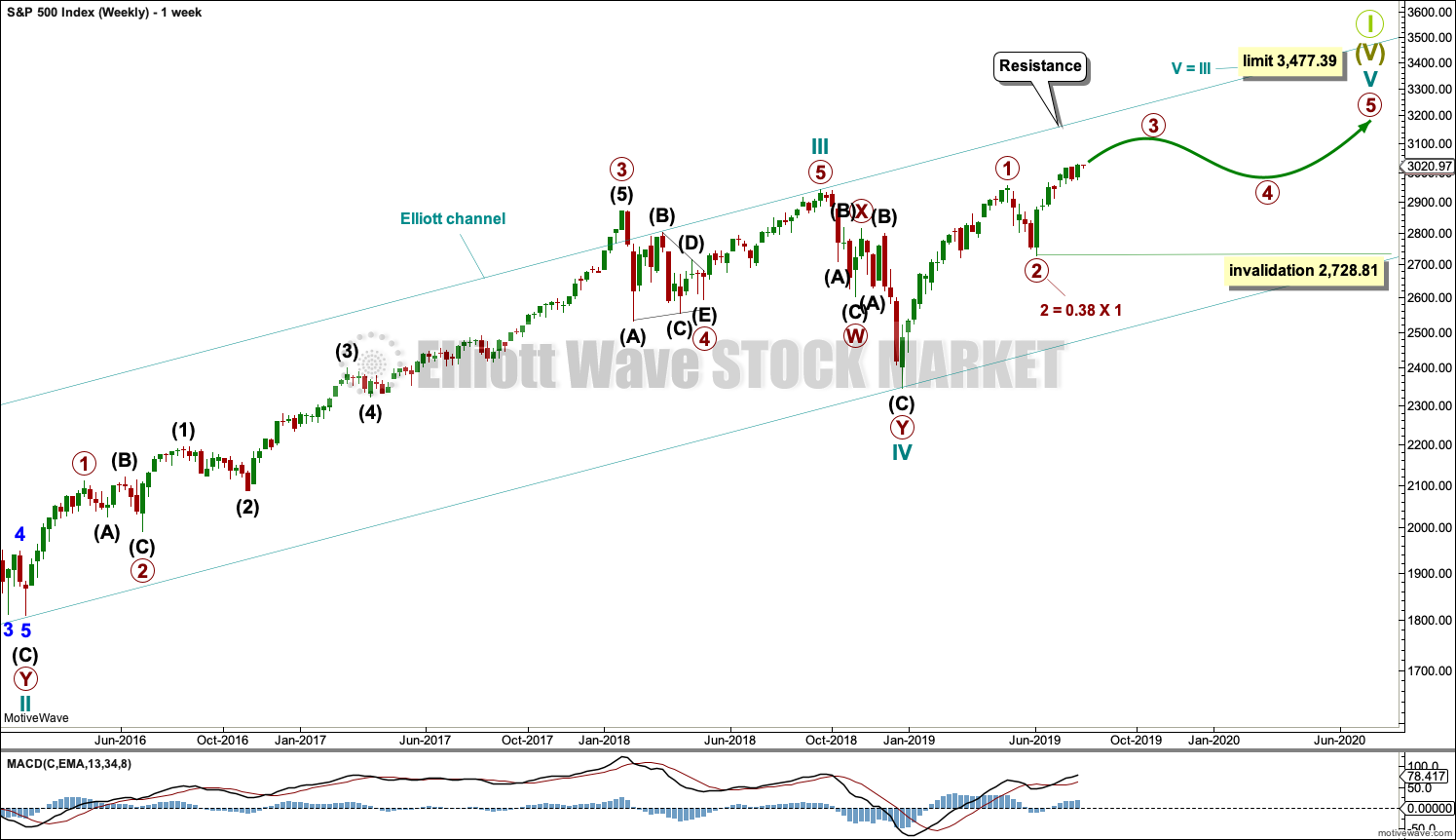
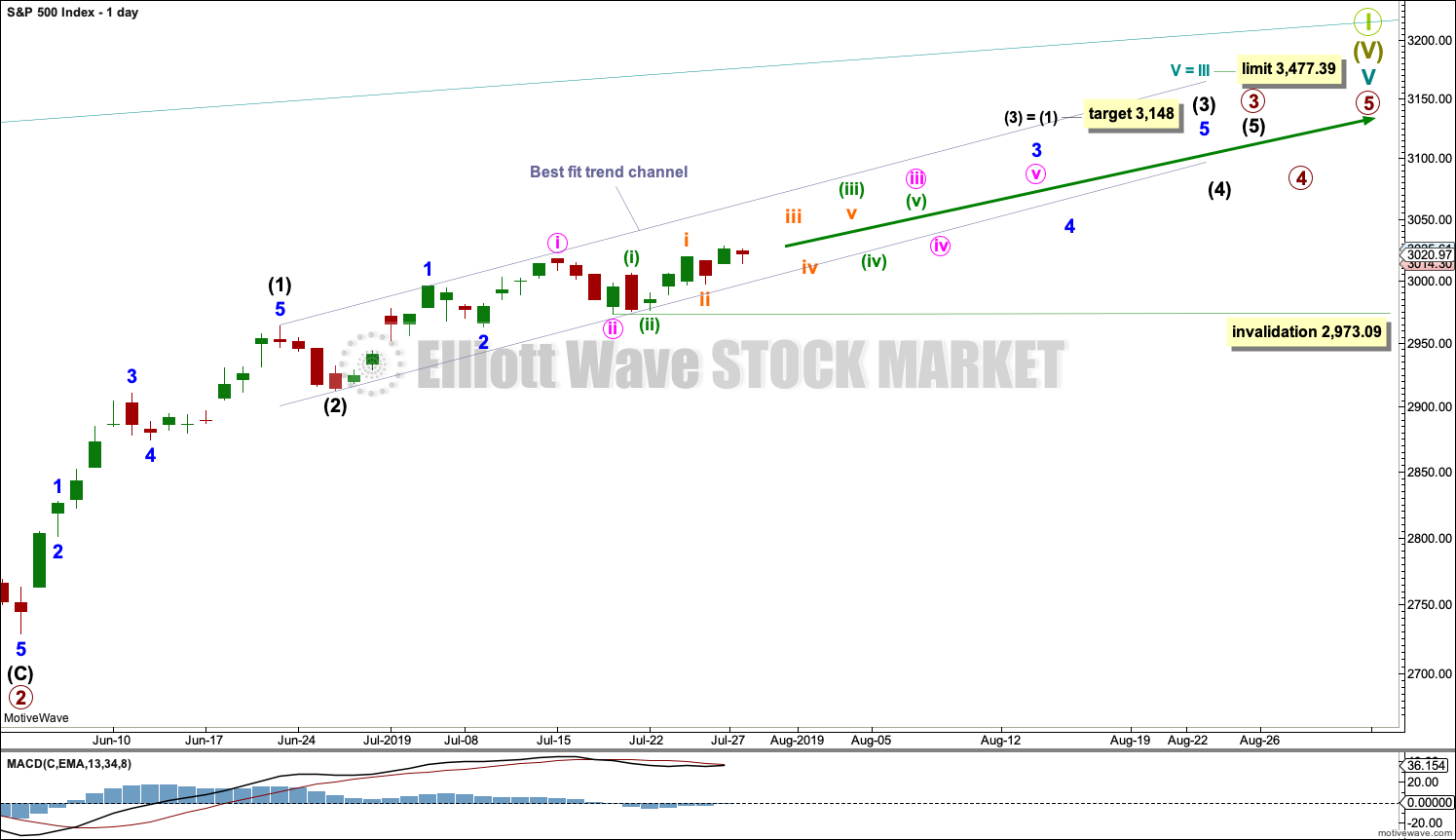
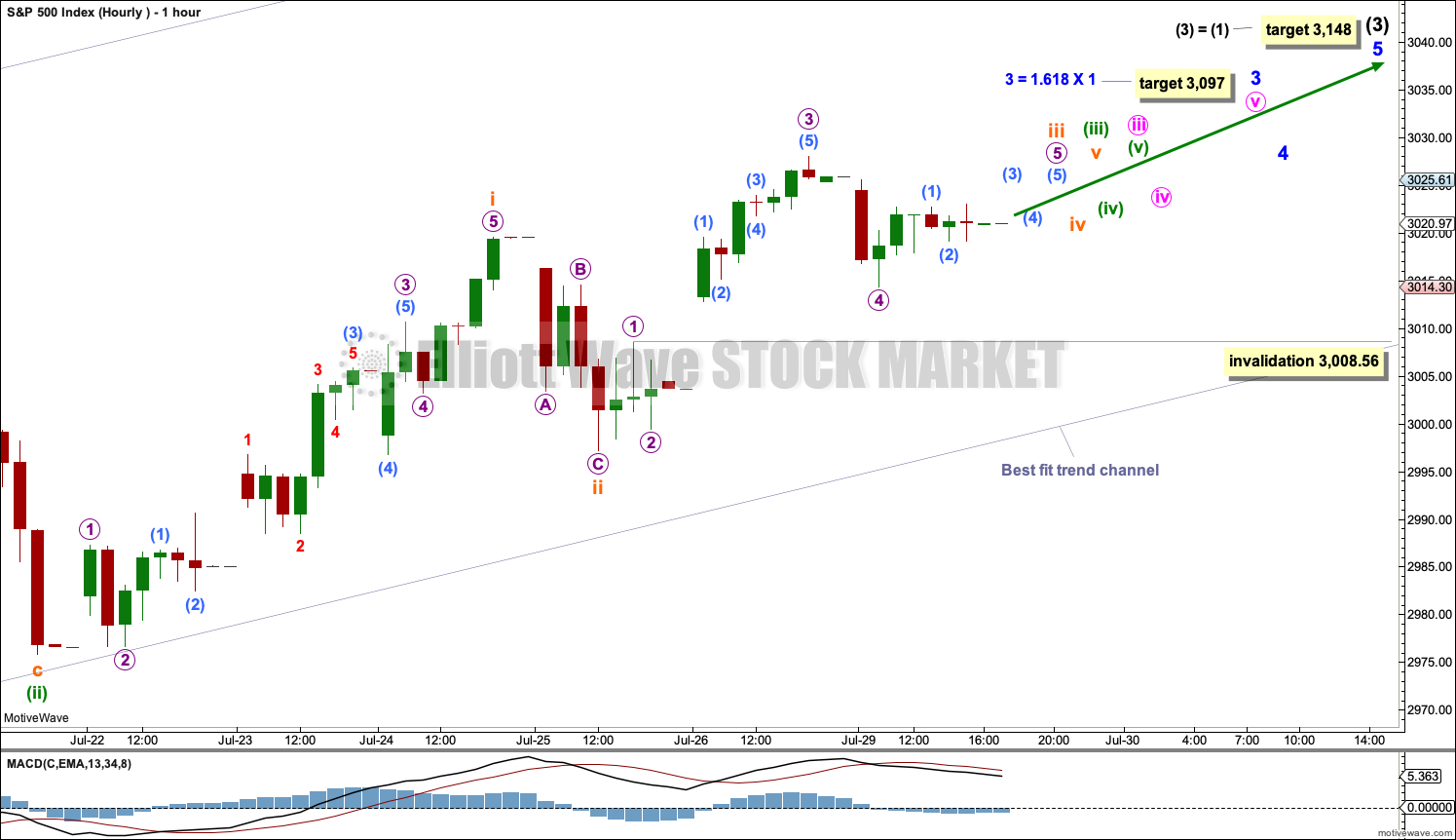
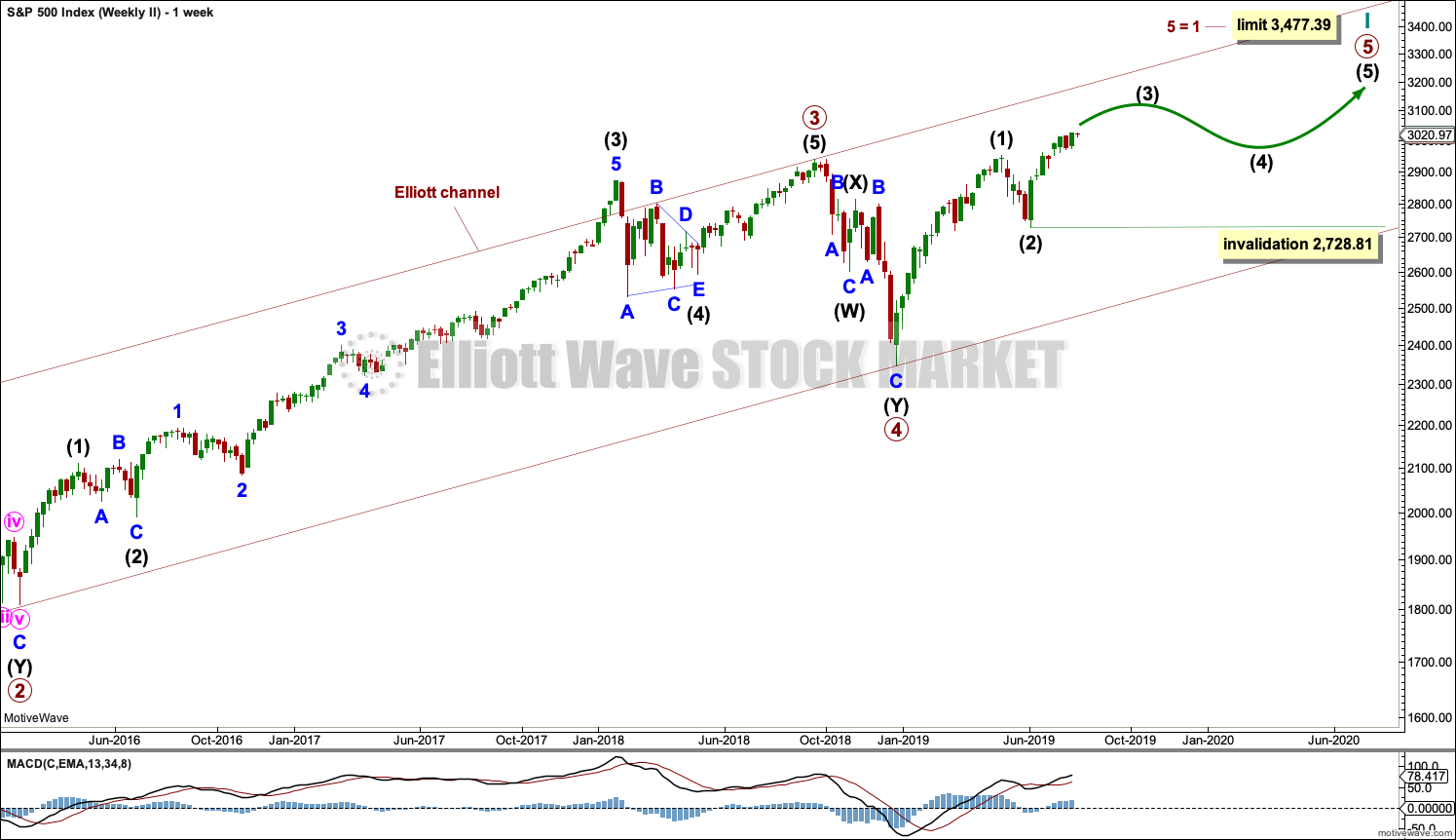
Hourly chart updated:
The invalidation point was too low and was breached.
The count is changed to see another first and second wave complete.
There may now be a series of seven first and second waves complete. The support line remains intact.
RUT…
I might clarify. Another words a large degree 5 is still ahead after we decline to finish the triangle and a 4. Various targets out there for 5 from 3400 and higher.
Hi Lara,
I am attaching a wkly chart of a count that you likely have seen or considered. I am seeing this count expressed by several elliotticians.
Could you comment on why this count holds or does Not hold much of any probability.
As always…thank you…
It’s possible, in the way that many things are possible.
But the probability is exceptionally low.
My research and 11 years experience shows me expanding triangles are one of the rarest of Elliott wave structures. My research on now 3 markets found no examples at all. I think I might have seen one once on the USD index on an hourly chart. That’s it.
To base a wave count on one of the rarest structures would be to base ones analysis on an exceptionally low probability outcome. I’m not going to do that.
Also, the current upwards wave has underlying support from breadth, support from On Balance Volume. This does not look like a D wave of a triangle. It’s too strong.
And indeed, one thing I NEVER see associated with any and all EWI analyses is supporting (or not supporting in this case) technical analysis. On the other hand, they LOVE to cite extremes in sentiment to justify their constant bearishness.
This call by them came out just about 2 or maybe 3 months ago, by the way. It’s relatively new. I believe it was the May edition of their monthly “analysis”.
Looks like the main was invalidated, but still within best fit channel and holding 3k ahead of FOMC. What’s the group think here?
Nailed it.